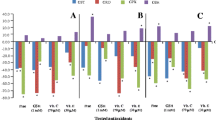Abstract
Twenty-seven pesticides, with which people are concerned, especially as residues in food, were examined in vitro for their effects on hepatocytes, mitochondria, and microsomes isolated from male rats. Nineteen pesticides returned non-protein sulfhydryl (NPSH) contents in hepatocytes to less than 80% of control at concentrations from 10−3 to 10−5 M after 90 min incubation. Among them, only dichlofluanid was reactive with glutathione non-enzymatically. Lipid peroxidation in hepatocytes was stimulated by five pesticides at 10−3 M, with edifenphos being the most potent peroxidant. Cell viability was considerably decreased by incubation with chlorobenzilate, edifenphos, dichlofluanid, and chinomethionat at 10−3 M, and in these cases, depletion of cellular adenosine 5′-triphosphate (ATP) contents proceeded to cell death. With respect to isolated mitochondrial respiration, six pesticides inhibited state 3 and/or state 4 respiration rates at concentrations from 10−3 to 10−5 M, whereas three pesticides uncoupled state 4 respiration at 10−3 M. With respect to isolated microsomal lipid peroxidation, seven pesticides, five of which were organophosphorus compounds, were peroxidative at concentrations from 10−3 to 10−5 M, whereas seven pesticides were antioxidative at concentrations from 10−3 to 10−7 M. Only three pesticides, aldicarb, maleic hydrazide, and chlormequat chloride had no effect on any parameters tested at 10−3 M. Pesticides that affected isolated mitochondria or microsomes did not necessarily have any effect on isolated hepatocytes.
Similar content being viewed by others
References
Baron RL (1991) Carbamate insecticides. In: Hayes WJ Jr, Laws ER Jr (eds) Handbook of pesticide toxicology. Academic Press, NY, pp 1125–1189
Brewster DW, Warren J, Hopkins II WE (1991) Metabolism of glyphosate in Sprague-Dawley rats: Tissue distribution, identification, and quantitation of glyphosate-derived materials following a single oral dose. Fundam Appl Toxicol 17:43–51
Buege JA, Aust SD (1978) Microsomal lipid peroxidation. In: Fleischer S and Packer L (eds) Methods in enzymology. Academic Press, NY, vol 52, pp 302–310
Bus JS, Gilson JE (1984) Paraquat: Model for oxidant-initiated toxicity. Environ Health Perspect 55:37–46
Carlson GP, DuBois KP (1970) Studies on the toxicity and biochemical mechanism of action of 6-methyl-2,3-quinoxalinedithiol cyclic carbonate (Morestan). J Pharmacol Exper Ther 173:60–70
Casida JE (1973) Insecticide biochemistry. Annu Rev Biochem 42:259–278
Cinti DL, Moldeus P, Schenkman JB (1972) Kinetic parameters of drug-metabolizing enzymes in Ca2+-sedimented microsomes from rat liver. Biochem Pharmacol 21:3249–3256
Costa LG, Gastel J, Murphy SD (1991) The formamidine pesticides chlordimeform and amitraz decrease hepatic glutathione in mice through an interaction with alpha2-adrenoceptors. J Toxicol Environ Health 33:349–358
Cutkomp LK, Yap HH, Vea EV, Koch RB (1971) Inhibition of oligomycin-sensitive (mitochondrial) Mg2+-ATP ase by DDT and selected analogs in fish and insect tissue. Life Sci 10:1201–1209
Ellman GL (1959) Tissue sulfhydryl groups. Arch Biochem Biophys 82:70–77
Fayez V, Kilgore WW (1992) Acute toxic effects of oxamyl in the rat. Fundam Appl Toxicol 18:155–159
Fukami J (1980) Metabolism of several insecticides by glutathione S-transferases. Pharmacol Ther 10:473–514
Jao LT, Casida JE (1974) Insect pyrethroid-hydrolyzing esterases. Pest Biochem Physiol 4:465–472
Johnson D, Henry L (1967) Isolation of liver and kidney mitochondria. In: Estabrook RW, Pullman ME (eds) Methods in enzymology. Academic Press, NY, vol 10, pp 94–96
Kim HL (1991) Accumulation of ethoxyquin in the tissue. J Toxicol Environ Health 33:229–236
Kozumbo WJ, Seed JL, Kensler TW (1983) Inhibition by 2(3)-tert-butyl-4-hydroxyanisole and other antioxidants of epidermal ornithine decarboxylase activity induced by 12-O-tetradecanoylphorbol-13-acetate. Cancer Res 43:2555–2559
Kraus-Friedman N, Biber J, Muren H, Carafoli E (1982) Calcium uptake in isolated hepatic plasma-membrane vesicles. Eur J Biochem 129:7–12
Motoyama N, Dauterman WC (1980) Glutathione S-transferases: Their role in the metabolism of organophosphorus insecticides. In: Hodgson E, Bend JR, Philpot RM (eds) Reviews in biochemical toxicology. Elsevier, NY, pp 49–69
Nagamatsu K, Kido Y, Terao T, Ishida T, Toki S (1982) Protective effect of sulfhydryl compounds on acute toxicity of morphine. Life Sci 30:1121–1127
Schattenberg HJ III, Hsu JP (1992) Pesticide residue survey of produce from 1989 to 1991. J Assoc Offic Anal Chem 75:925–933
Seglen PO (1976) Preparation of isolated rat liver cell. In: Wilson L (ed) Methods in cell biology. Academic Press, NY, vol 13, pp 29–83
Sultatos LG, Woods L (1988) The role of glutathione in the detoxification of the insecticides methyl parathion and azinphos-methyl in the mouse. Toxicol Appl Pharmacol 96:168–174
Szarkowska L, Klingenberg M (1963) The role of ubiquinone in mitochondria. Biochem Z 338:674–697
Tomizawa C, Ueji M, Koshioka M (1989) Pesticide data book. Soft Science Publications, Tokyo.
Yamano T, Morita S (1992) Hepatotoxicity of trichlorfon and dichlorvos in isolated rat hepatocytes. Toxicology 76:69–77
Author information
Authors and Affiliations
Rights and permissions
About this article
Cite this article
Yamano, T., Morita, S. Effects of pesticides on isolated rat hepatocytes, mitochondria, and microsomes. Arch. Environ. Contam. Toxicol. 25, 271–278 (1993). https://doi.org/10.1007/BF00212141
Received:
Revised:
Issue Date:
DOI: https://doi.org/10.1007/BF00212141




